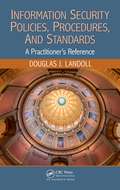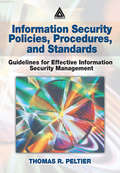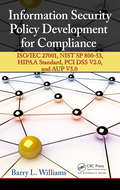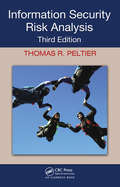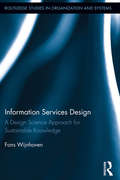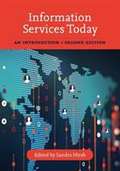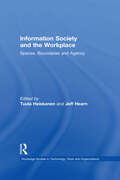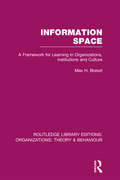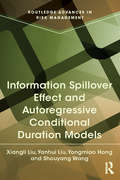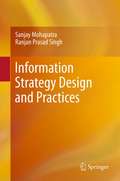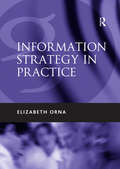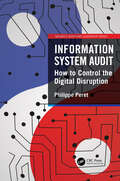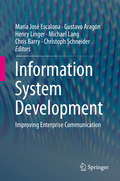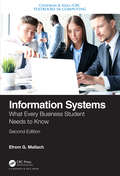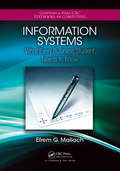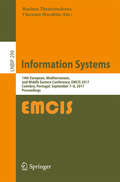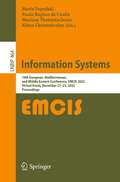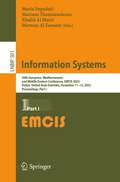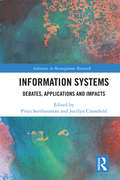- Table View
- List View
Information Security Policies, Procedures, and Standards: A Practitioner's Reference
by Douglas J. LandollInformation Security Policies, Procedures, and Standards: A Practitioner's Reference gives you a blueprint on how to develop effective information security policies and procedures. It uses standards such as NIST 800-53, ISO 27001, and COBIT, and regulations such as HIPAA and PCI DSS as the foundation for the content. Highlighting key terminology, policy development concepts and methods, and suggested document structures, it includes examples, checklists, sample policies and procedures, guidelines, and a synopsis of the applicable standards. The author explains how and why procedures are developed and implemented rather than simply provide information and examples. This is an important distinction because no two organizations are exactly alike; therefore, no two sets of policies and procedures are going to be exactly alike. This approach provides the foundation and understanding you need to write effective policies, procedures, and standards clearly and concisely. Developing policies and procedures may seem to be an overwhelming task. However, by relying on the material presented in this book, adopting the policy development techniques, and examining the examples, the task will not seem so daunting. You can use the discussion material to help sell the concepts, which may be the most difficult aspect of the process. Once you have completed a policy or two, you will have the courage to take on even more tasks. Additionally, the skills you acquire will assist you in other areas of your professional and private life, such as expressing an idea clearly and concisely or creating a project plan.
Information Security Policies, Procedures, and Standards: Guidelines for Effective Information Security Management
by Thomas R. PeltierBy definition, information security exists to protect your organization's valuable information resources. But too often information security efforts are viewed as thwarting business objectives. An effective information security program preserves your information assets and helps you meet business objectives. Information Security Policies, Procedure
Information Security Policy Development for Compliance: ISO/IEC 27001, NIST SP 800-53, HIPAA Standard, PCI DSS V2.0, and AUP V5.0
by Barry L. WilliamsAlthough compliance standards can be helpful guides to writing comprehensive security policies, many of the standards state the same requirements in slightly different ways. Information Security Policy Development for Compliance: ISO/IEC 27001, NIST SP 800-53, HIPAA Standard, PCI DSS V2.0, and AUP V5.0 provides a simplified way to write policies that meet the major regulatory requirements, without having to manually look up each and every control. Explaining how to write policy statements that address multiple compliance standards and regulatory requirements, the book will help readers elicit management opinions on information security and document the formal and informal procedures currently in place. Topics covered include:Entity-level policies and procedures, Access-control policies and procedures, Change control and change management, System information integrity and monitoring, System services acquisition and protection, Informational asset management, Continuity of operations. The book supplies you with the tools to use the full range of compliance standards as guides for writing policies that meet the security needs of your organization. Detailing a methodology to facilitate the elicitation process, it asks pointed questions to help you obtain the information needed to write relevant policies. More importantly, this methodology can help you identify the weaknesses and vulnerabilities that exist in your organization. A valuable resource for policy writers who must meet multiple compliance standards, this guidebook is also available in eBook format. The eBook version includes hyperlinks beside each statement that explain what the various standards say about each topic and provide time-saving guidance in determining what your policy should include.
Information Security Risk Analysis
by Thomas R. PeltierSuccessful security professionals have had to modify the process of responding to new threats in the high-profile, ultra-connected business environment. But just because a threat exists does not mean that your organization is at risk. This is what risk assessment is all about. Information Security Risk Analysis, Third Edition demonstrates how to id
Information Services Design: A Design Science Approach for Sustainable Knowledge (Routledge Studies in Organization and Systems)
by Fons WijnhovenInformation services are economic and organizational activities for informing people. Because informing is changing rapidly under the influence of internet-technologies, this book presents in Chapter 1 fundamental notions of information and knowledge, based on philosopher C.W. Churchman’s inquiring systems. This results in the identification of three product-oriented design theory aspects: content, use value and revenue. Chapter 2 describes how one can cope with these aspects by presenting process-oriented design theory. Both design theory insights are applied in chapters on information services challenges, their business concepts and processes, their architectures and exploitation. The final chapter discusses three case studies that integrate the insights from previous chapters, and it discusses some ideas for future research. This book gives students a coherent start to the topic of information services from a design science perspective, with a balance between technical and managerial aspects. Therefore, this book is useful for modern curricula of management, communication science and information systems. Because of its design science approach, it also explains design science principles. The book also serves professionals and academics in search of a foundational understanding of informing as a science and management practice.
Information Services Today: An Introduction
by Sandra HirshThis essential overview of what it means to be a library and information professional today provides a broad overview of the transformation of libraries as information organizations, why these organizations are more important today than ever before, the technological influence on how we provide information resources and services in today’s digital and global environment, and the various career opportunities available for information professionals. The book begins with a historical overview of libraries and their transformation as information and technology hubs within their communities. It also covers the various specializations within the field emphasizing the exciting yet complex roles and opportunities for information professionals. With that foundation in place, it presents how libraries serve different kinds of communities, highlighting the unique needs of users across all ages and how libraries fulfill those needs through a variety of services, and addresses key issues facing information organizations as they meet user needs in the Digital Age. The book then concludes with career management strategies to guide library and information science professionals in building not only vibrant careers but vibrant information organizations for the future as well.
Information Society and the Workplace: Spaces, Boundaries and Agency (Routledge Studies in Technology, Work and Organizations #Vol. 1)
by Jeff Hearn Tuula HeiskanenMuch has been written on the grand prospects for "Information Society"; much less on what this might mean in everyday terms. So what do we find when we look at what is happening in a society, Finland, that is one of closest to an information society? Bringing together studies of everyday local practices in workplaces within information society, this book has a special focus on social space and the agency of actors. It includes both theoretical reviews and detailed qualitative research. It also highlights the political challenges of the information society, challenges which are likely to become subjects of international concern.
Information Space: A Framework For Learning In Organizations, Institutions, And Culture (Routledge Library Editions: Organizations)
by Max BoisotIn this book the author lays the foundations for a new political economy of information. The information space, or I-Space is the conceptual framework in which organizations, institutions and cultures are being transformed by new information and communication technologies. In the penultimate chapter, the I-Space’s usefulness as an explanatory framework is illustrated with an application: a case study of China’s modernization. Information Space proposes a radical shift in the way that we approach the emerging information age and the implications it holds for societies, organizations and individuals.
Information Spillover Effect and Autoregressive Conditional Duration Models (Routledge Advances in Risk Management)
by Xiangli Liu Yanhui Liu Yongmiao Hong Shouyang WangThis book studies the information spillover among financial markets and explores the intraday effect and ACD models with high frequency data. This book also contributes theoretically by providing a new statistical methodology with comparative advantages for analyzing comovements between two time series. It explores this new method by testing the information spillover between the Chinese stock market and the international market, futures market and spot market. Using the high frequency data, this book investigates the intraday effect and examines which type of ACD model is particularly suited in capturing financial duration dynamics. The book will be of invaluable use to scholars and graduate students interested in comovements among different financial markets and financial market microstructure and to investors and regulation departments looking to improve their risk management.
Information Strategy Design and Practices
by Ranjan Prasad Singh Sanjay MohapatraInformation Strategy Design and Practices develops a framework for designing information technology strategy for an organization. Beyond this, it establishes an approach to not only implement it, but sustain it. The framework explains how IT strategy should have an alignment to business to reap the benefits of business. The book contains five case studies in different domains: retail, real estate development, IT product development, development sector, and education sector. These case studies have been applied to different countries, providing a global prospective to this emerging trend.
Information Strategy in Practice
by Elizabeth OrnaLiz Orna's original Practical Information Policies has become a standard text which has helped information managers in many countries to take productive action in their own environment: to get a job they wanted, carry through an information audit, make a successful business case for an information policy, or formulate an information strategy. This book is designed specially for students preparing to enter the information professions; working professionals in other fields, whose job includes an information-management element; and senior managers from other specialisms who have overall responsibilities for information activities. Information Strategy in Practice provides, in brief and practical form, and informal style: ¢ a reliable account of the key processes involved in developing organizational information policy and strategy, with realistic suggestions on carrying them through, drawn from actual practice ¢ a sound framework of the ideas underlying the practice recommended, which readers can relate to their own context ¢ advice from experience about dealing with the kind of problems that often beset information-strategy development, and about getting the best from the process.
Information System Audit: How to Control the Digital Disruption (Security, Audit and Leadership Series)
by Philippe PeretThe digitalization of companies is a recurrent topic of conversation for managers. Companies are forced to evolve at least as fast as their competitors. They have to review their organization, their processes, and their way of working. This also concerns auditors in terms of their audit strategy and working methods. Digitalization is the tip of the iceberg that represents the increasing reliance on information technology of the company’s information system. Companies have seen new competitors succeed with a digital approach, competitors that have opened new markets or new ways of interacting with their customers, and all business processes can be digitalized. In this new paradigm, auditors have to renew themselves too. Long gone are the days of auditors specializing in one technique, like financial auditors or IT auditors. This makes it a phenomenal opportunity for auditing to renew itself, embracing the vision of the company’s information system: long live the information system auditors! This book proposes you to go step by step from a common understanding of our history of auditing to gradually defining and justifying the impacts of digitalization on the audit strategy and the preparation of audits.
Information System Development: Improving Enterprise Communication
by María José Escalona Gustavo Aragón Henry Linger Michael Lang Chris Barry Christoph SchneiderInformation System Development--Improving Enterprise Communication are the collected proceedings of the 22nd International Conference on Information Systems Development: Improving Enterprise Communication--ISD 2013 Conference, held in Seville, Spain. It follows in the tradition of previous conferences in the series in exploring the connections between industry, research and education. These proceedings represent ongoing reflections within the academic community on established information systems topics and emerging concepts, approaches and ideas. It is hoped that the papers herein contribute towards disseminating research and improving practice. The conference tracks highlighted at the 22nd International Conference on Information Systems Development (ISD 2013) were: Applications Data and Ontologies End Users Enterprise Evolution Industrial cases in ISD Intelligent Business Process Management Model Driven Engineering in ISD New Technologies Process Management Quality
Information Systems: A Manager's Guide to Harnessing Technology, Version 3.0
by John GallaugherWHAT'S NEW IN 3.0:<P><P> UPDATED, MORE RELEVANT INFORMATION:<P> New coverage including Uber, WhatsApp, Facebook, and bitcoin breathes fresh life into existing material. The popular Zara and Netflix case studies remain but contain refreshed information.<P> EMPHASIS ON SOCIAL MEDIA:<P> Instagram, SnapChat, WhatsApp, Tinder, Secret, and Whisper all receive mention, ensuring relevancy and proper understanding of the current field.<P> MOBILE VS. DESKTOP:<P> In a number of renamed chapters, Gallaugher weighs the pros and cons of social media use on desktop computers and mobile devices, prompting classroom dialogue surrounding the rise of different technologies and how businesses and managers adjust to emerging trends.<P> DISCUSSION OF THE SHARING ECONOMY:<P> With the addition of an entirely new chapter focused on the sharing economy, Gallaugher introduces examples of citizens coming together to create or share resources across markets.<P> For a comprehensive list of what's new in version 3.0, visit Gallaugher’s blog.<P> John Gallaugher of Boston College was one of BusinessWeek’s “Professors of the Year.” His widely popular textbook offers a proven approach that has garnered student praise and increased information systems enrollment. There is no other Information Systems author today who keeps his text as "up-to-the-month" current. <P> For regular updates, follow Gallaugher’s blog, The Week in Geek, and connect with him on Twitter at @gallaugher.<P> This textbook is suitable for these courses:Undergraduate or graduate courses in Management Information Systems and Information Technology<P> This textbook is suitable for 2 and 4 year institutions.<P> PEDAGOGICAL FEATURES:<P> FOCUS ON STRATEGIC THINKING:<P> Rather than lead with technical topics, the book starts with strategic thinking, focusing on big-picture issues that have confounded experts but will engage students.<P> ENGAGING CASE STUDIES:<P> While chapters introduce concepts, cases on approachable, exciting firms across industries further challenge students to apply what they've learned.<P> CUSTOMIZABILITY:<P> The Flat World Knowledge publishing model allows instructors to adapt the textbook to the exact needs of their specific class and student body. <P>
Information Systems: A Manager's Guide to Harnessing Technology, v. 5.0
by John GallaugherWHAT'S NEW IN 5.0:<P><P> FRESHLY UPDATED:<P> Every chapter has received an update to ensure that it covers the latest topics and material. Today’s cutting edge firms and headline grabbing topics are presented through durable frameworks and concepts.<P> WORLDWIDE TRENDS IN TECH DEVELOPMENTS:<P> Included are updates and statistics on companies and technologies being developed around the world. China started the century as a nation largely unplugged and offline, but now has more internet users than any other country. In Sub-Saharan Africa, 70% of the population lives within mobile cell phone coverage. Now, even drones are affordable enough to be used as a delivery system in places with poor infrastructure.<P> PROTEUS, A PILL CAMERA:<P> A mini-case in the “Moore’s Law and More” chapter discusses the launch of Proteus’s low cost and efficient “PillCam.” Using small sensors and powered by digestive acids, the pill allows doctors to see a unique perspective inside the human body (literally).<P> SOCIAL MEDIA POWERHOUSE:<P> Statistics on the massive amount of new social networks and acquisitions in the marketplace have all been updated. New content includes Microsoft’s acquisition of LinkedIn, Slack’s dominant presence in the business space, and the rise of companies like HubSpot. New subsections discuss Twitter and the rise of microblogging, as well as Facebook’s dominant news feed and its strong position against Google’s advertising monopoly.<P> CUTTING EDGE COVERAGE:<P> From Facebook’s move to make Messenger a platform to Google’s evolution to Alphabet, students will feel their text and classroom are alive with the most current content available.<P> For a comprehensive list of what's new in version 5.0, visit Gallaugher’s blog.<P> John Gallaugher of Boston College has been named one of Entrepreneur Magazine’s “Gurus to Grads.” His popular and award-winning textbook offers a proven approach that has garnered student praise and increased information systems enrollment. Each year Gallaugher meets with scores of tech industry executives from Silicon Valley to sub-Saharan Africa, and there is no other Information Systems author today who keeps his text as "up-to-the-month" current. <P> For regular updates, follow Gallaugher’s blog, The Week in Geek, and connect with him on Twitter at @gallaugher.<P> This textbook is suitable for these courses:Undergraduate or graduate courses in Management Information Systems and Information Technology<P> This textbook is suitable for 2 and 4 year institutions.<P> PEDAGOGICAL FEATURES:<P> FOCUS ON STRATEGIC THINKING:<P> Rather than lead with technical topics, the book starts with strategic thinking, focusing on big-picture issues that have confounded experts but will engage students.<P> CURRENT, ENGAGING AND HOLISTIC CASE STUDIES:<P> While chapters introduce concepts, cases on approachable, exciting firms across industries further challenge students to apply what they've learned. Students love how concepts are introduced in a text that reads more like Wired and the Wall Street Journal than a conventional textbook.<P> CONCEPTS:<P> Chapters cover not only strategy and technology basics, but critical and cutting edge concepts such as data analytics, security, social media, the sharing economy, disruptive innovation, network effects and platform creation, open source, and cloud computing.<P> FASCINATING FIRMS:<P> In-depth profiles include firms that students know and are eager to learn more about. Amazon, Facebook, Google, Netflix, Rent the Runway, and Zara are among the firms that get extended coverage, along with mini-cases on Airbnb, Uber, and more.<P> CUSTOMIZABILITY:<P> The Flat World Knowledge publishing model allows instructors to adapt the textbook to the exact needs of their specific class and student body. See how easy it is to customize a textbook in this 4 minute demo: Flat World Editing Platform Video Demo
Information Systems: A Manager’s Guide to Harnessing Technology
by John GallaugherThe text offers a proven approach that has garnered student praise, increased IS enrollment, and engaged students to think deeper and more practically about the space where business and technology meet. Every topic is related to specific business examples, so students gain an immediate appreciation of its importance. Rather than lead with technical topics, the book starts with strategic thinking, focusing on big-picture issues that have confounded experts but will engage students. And while chapters introduce concepts, cases on approachable, exciting firms across industries further challenge students to apply what they've learned, asking questions like: Why was NetFlix able to repel Blockbuster and WalMart? How did Harrah's Casino's become twice as profitable as comparably-sized Caesar's, enabling the former to acquire the latter? How does Spain's fashion giant Zara, a firm that shuns the sort of offshore manufacturing used by every other popular clothing chain, offer cheap fashions that fly off the shelves, all while achieving growth rates and profit margins that put Gap to shame? What's an IPO and can a technology alternative push out investment bankers and insiders to the benefit of entrepreneurs and small investors? Why is Google more profitable than Disney? Is Facebook really worth $15 billion?
Information Systems: A Manager's Guide to Harnessing Technology version 1.2
by John GallaugherInformation Systems: A Manager's Guide to Harnessing Technology V1.2 is intended for use in undergraduate and/or graduate courses in Management Information Systems and Information Technology. Version 1.2 of John's book retains the same structure and theory of version 1.1, but refreshes key statistics, examples, and brings case material up to date (vital when covering firms that move as fast as Facebook, Google, and Netflix). Adopting version 1.2 guarantees your students will have the most current text on the market, drawing real and applicable lessons from material that will keep your class offerings current and accessible.
Information Systems: A Manager's Guide to Harnessing Technology version 1.3
by John GallaugherInformation Systems: A Manager's Guide to Harnessing Technology V 1.3 is intended for use in undergraduate and/or graduate courses in Management Information Systems and Information Technology. Version 1.3 of John's book retains the same structure and theory of version 1.1 and V 1.2, but refreshes key statistics, examples, and brings case material up to date (vital when covering firms that move as fast as Facebook, Google, and Netflix). For example; the Netflix chapter - Updates address the major changes impacting Netflix in 2011, including the response to the firm's pricing changes, the failed Qwikster service split, recent developments impacting the streaming and DVD-by-mail businesses, a comparison table detailing the stark differences between the firm's two offerings (DVD & streaming), updated statistics, learning objectives, and additional exercises and updates to the Google chapter - Updated text/images for currency, additional sub-sections on the firm's Google+ launch and the acquisition of Motorola Mobility. Adopting version 1.3 guarantees your students will have the most current text on the market, drawing real and applicable lessons from material that will keep your class offerings current and accessible.
Information Systems: A Manager's Guide to Harnessing Technology version 1.4
by John GallaugherInformation Systems: A Manager’s Guide to Harnessing Technology V 1.4 is intended for use in undergraduate and/or graduate courses in Management Information Systems and Information Technology. Version 1.4 of John's book retains the same structure and theory of the earlier versions, but Version 1.4 updates key statistics and examples, and includes up-to-date case material, such as Pinterest and Facebook’s Instagram acquisition. Adopting version 1.4 guarantees your students will have the most current text on the market, drawing real and applicable lessons from material that will keep your class offerings current and accessible.
Information Systems: What Every Business Student Needs to Know, Second Edition (Chapman & Hall/CRC Textbooks in Computing)
by Efrem G. MallachMost information systems textbooks overwhelm business students with overly technical information they may not need in their careers. This textbook takes a new approach to the required information systems course for business majors. For each topic covered, the text highlights key "Take-Aways" that alert students to material they will need to remember during their careers. Sections titled "Where You Fit In" and "Why This Chapter Matters" explain how the topics being covered will impact students on the job. Review questions, discussion questions, and summaries are also included. This second edition is updated to include new technology, along with a new running case study. Key features: Single-mindedly for business students who are not technical specialists Doesn&’t try to prepare IS professionals; other courses will do that Stresses the enabling technologies and application areas that matter the most today Based on the author&’s real-world experience Up to date regarding technology and tomorrow&’s business needs This is the book the author—and, more importantly, his students—wishes he had when he started teaching. Dr. Mallach holds degrees in engineering from Princeton and MIT, and in business from Boston University. He worked in the computer industry for two decades, as Director of Strategic Planning for a major computer firm and as co-founder/CEO of a computer marketing consulting firm. He taught information systems in the University of Massachusetts (Lowell and Dartmouth) business schools for 18 years, then at Rhode Island College following his retirement. He consults in industry and serves as Webmaster for his community, in between hiking and travel with his wife.
Information Systems: What Every Business Student Needs to Know (Chapman & Hall/CRC Textbooks in Computing)
by Efrem G. MallachMost information systems (IS) texts overwhelm business students with overly technical information they may not need in their careers. This textbook takes a new approach to the required IS course for business majors. For each topic covered, the text highlights key "Take-Aways" that alert students to material they will need to remember during their careers. Sections titled "Where You Fit In" and "Why This Chapter Matters" explain how the topics being covered will impact students once they are on the job. Review questions, discussion questions, and summaries are included in each chapter.
Information Systems: 14th European, Mediterranean, and Middle Eastern Conference, EMCIS 2017, Coimbra, Portugal, September 7-8, 2017, Proceedings (Lecture Notes in Business Information Processing #299)
by Marinos Themistocleous and Vincenzo MorabitoThis book constitutes selected papers from the 14th European, Mediterranean, and Middle Eastern Conference, EMCIS 2017, held in Coimbra, Portugal, in September 2017. EMCIS is focusing on approaches that facilitate the identification of innovative research of significant relevance to the IS discipline following sound research methodologies that lead to results of measurable impact. The 37 full and 16 short papers presented in this volume were carefully reviewed and selected from a total of 106 submissions. They are organized in sections on big data and Semantic Web; digital services, social media and digital collaboration; e-government; healthcare information systems; information systems security and information privacy protection; IT governance; and management and organizational issues in information systems.
Information Systems: 19th European, Mediterranean, and Middle Eastern Conference, EMCIS 2022, Virtual Event, December 21–22, 2022, Proceedings (Lecture Notes in Business Information Processing #464)
by Maria Papadaki Paulo Rupino da Cunha Marinos Themistocleous Klitos ChristodoulouThis book constitutes selected papers from the 19th European, Mediterranean, and Middle Eastern Conference, EMCIS 2022, which was held virtually during December 7-8, 2022.EMCIS covers technical, organizational, business, and social issues in the application of information technology and is dedicated to the definition and establishment of Information Systems (IS) as a discipline of high impact for IS professionals and practitioners. It focuses on approaches that facilitate the identification of innovative research of significant relevance to the IS discipline following sound research methodologies that lead to results of measurable impact. The 47 papers presented in this volume were carefully reviewed and selected from a total of 136 submissions. They were organized in topical sections named: Artificial intelligence; big data and analytics; blockchain technology and applications; cloud computing; digital governance; digital services and social media; emerging computing technologies and trends for business process management; enterprise systems; information system security and information privacy protection; innovative research projects; IT governance and alignment; management and organizational issues in information systems; and metaverse.
Information Systems: 20th European, Mediterranean, and Middle Eastern Conference, EMCIS 2023, Dubai, United Arab Emirates, December 11-12, 2023, Proceedings, Part I (Lecture Notes in Business Information Processing #501)
by Maria Papadaki Marinos Themistocleous Khalid Al Marri Marwan Al ZarouniThis book constitutes selected papers from the 20th European, Mediterranean, and Middle Eastern Conference, EMCIS 2023, which was held in Dubai, UAE, during December 11-12, 2023. EMCIS covers technical, organizational, business, and social issues in the application of information technology and is dedicated to the definition and establishment of Information Systems (IS) as a discipline of high impact for IS professionals and practitioners. It focuses on approaches that facilitate the identification of innovative research of significant relevance to the IS discipline following sound research methodologies that lead to results of measurable impact. The 43 papers presented in this volume were carefully reviewed and selected from a total of 126 submissions. They were organized in topical sections as follows: Part I: Metaverse; blockchain technology and applications; digital governance; healthcare information systems; artificial intelligence; Part II: Big data and analytics; digital services and social media; innovative research projects; managing information systems; smart cities.
Information Systems: Debates, Applications and Impacts
by Priya Seetharaman Jocelyn CranefieldThis book captures a range of important developments that have occurred in Information Systems over the last forty years, with a particular focus on India and the developing world. Over this time, Information and Communications Technology (ICT) and Information Systems (IS) have come to play a critical role in supporting, complementing and automating managerial decisions, shaping and transforming industries, and contributing to deep societal and economic change. This volume examines a range of topics for those interested in the adoption and use of these technologies across varied situations. It combines empirical studies on the application and impact of IS with commentaries, debates and insights on the transformative role that IT and the IT industry have played, and continue to play, within India as well as globally. The book draws attention to issues and challenges that organizations grapple with in tech-enabled environments, and provides insights on the role of automation and computational techniques. It explores the global impact of the technology revolution on economic growth and development, electronic globalization, and the wider opportunities and challenges of a hi-tech world. The chapters cover various themes such as e-government in India, internet-based distribution systems, internet banking, and use of collaborative IT tools and functions to support virtual teams in the software industry and the business process outsourcing industry. Other chapters focus on methodological advances, such as systems thinking which finds applications in organizational decision-making, and the use of fuzzy logic. This volume will interest professionals and scholars of information technology and information systems, computer studies, IT systems, economics, and business and management studies.
